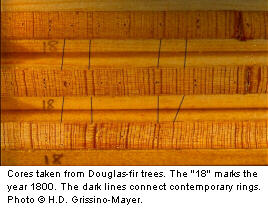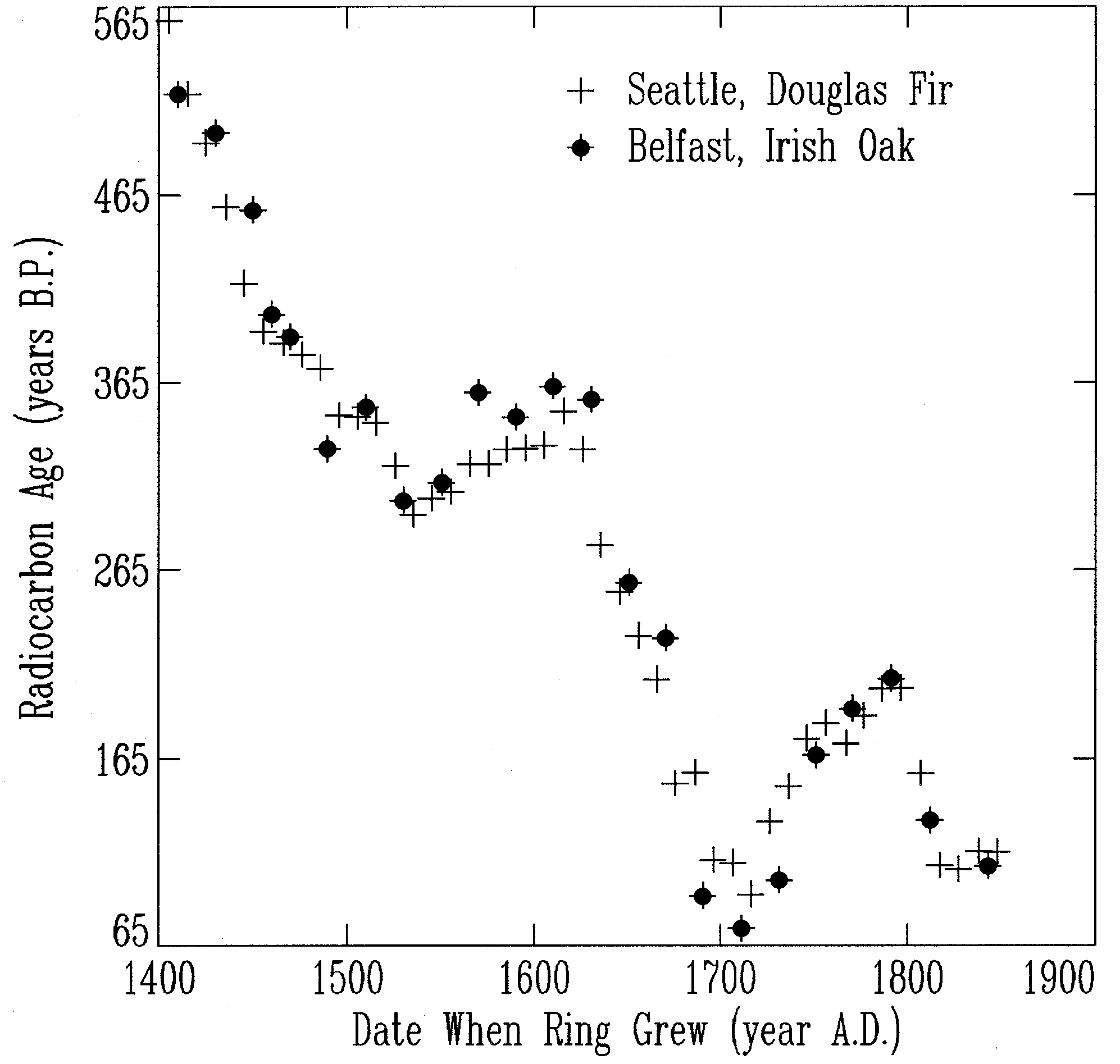
|
|
|
|
|
|
Home
About
Resources
anti-aging vitamins books
- A New Approach...
- The Exodus Happened 2450 B.C.
- Noah's Flood Happened 3520 B.C.
- Age of the Earth Collection
- Aging: Cause and Cure
- Bread from Heaven: The Manna Mystery Solved
newsletters
podcast
speaker for an event
time charts
videos
Topics
Overview
Biblical Chronology Dendrochronology Radiocarbon Dating Mt. Sinai Jericho Ai The Exodus Noah's Ark Imhotep/Joseph
Correspondence
- anti-aging vitamins
- antiquity of mankind
- ark search
- Bible chronology
- "The BC" publication
- Bryant Wood's critique
- calendars
- Heshbon
- horses and chariots in Egypt
- Jericho --- Joshua's curse
- lifespan research
- missing millennium: reception
- missing millennium: textual
- Mt. Sinai
- Noah's Flood
- Philistines
- radiocarbon
- Sodom and Gomorrah
- teaching science and creation
- the Exodus
- tree rings
- virtual history
- young earth creation
Contact Us
Are tree-ring chronologies reliable?The following article is abstracted from The Biblical Chronologist Volume 5, Number 1. Full details and references can be found there.Basic Concepts of DendrochronologyThe science of constructing chronologies from tree rings is called dendrochronology. The basic concepts involved are not complex. Modern trees are known to produce one growth ring per year. This is a result of the annual cycle of seasons. (The idea that ancient trees grew more than one ring per year will be discussed below.) Therefore, by coring a living tree and counting rings from the present backwards, it is possible to determine the year in which each ring grew. There are some very old living trees on earth. The bristlecone pines in the White Mountains of California live to extremely old ages, some in excess of 4,000 years. The University of Arizona dendrochronology lab sports a (no longer living) specimen which contains over 6,000 rings. Generally, it is not possible to construct a complete sequence of tree rings back through the historical periods using only living trees. Chronologies derived from living trees must be extended. This is accomplished using wood specimens found preserved, for example, in historic buildings, or on the forest floor, or in peat bogs. The rings in a non-living specimen can be counted to determine the number of years the specimen spans. But for the specimen to be useful in extending the tree-ring chronology, the absolute calendar age of its rings must be determined. The annual growth rings vary in thickness each year depending on environmental factors such as rainfall. By matching ring-width patterns in a specimen of known age (starting with living specimens) to ring-width patterns in an older specimen, the proper placement of the older specimen is determined. Tree-ring chronologies have been extended to 10,000 years before present in this way.  Some critics of dendrochronology suggest that the process of pattern-matching is highly error-prone. Are the long tree-ring chronologies inaccurate due to the inability of dendrochronologists to accurately match tree-ring patterns? We could discuss the details of pattern-matching technique or the probability of error, but there is another, more quantitative way, to determine if the long tree-ring chronologies are accurate or not. One can use the amount of radiocarbon in the individual tree rings. Because radiocarbon is everywhere the same in the atmosphere at any given time, tree rings which grew in the same year should have the same amount of radiocarbon. Furthermore, radiocarbon in the atmosphere fluctuates from year to year in a somewhat erratic fashion. This allows different dendrochronologies to be compared over multiple years to see if they show the same pattern of radiocarbon fluctuations. An Independent CheckEarly in the history of the science of dendrochronology, a tree-ring chronology using bristlecone pines from the White Mountains of California was developed. Separate dendrochronologies were then developed, also in America, using other types of trees, such as Douglas fir. These separate chronologies did not extend as far back in time because these types of trees are shorter-lived. However, they did agree with the bristlecone chronology as far back as it could be checked by the shorter chronologies. That is, rings of the same putative dendrochronological age were found to contain the same amount of radiocarbon, and to give the same pattern of fluctuations over time. These measurements demonstrated the basic validity of the science of dendrochronology. If the method had a large component of random error due to inaccurate pattern matching, how could such detailed agreement between the radiocarbon in the rings of two independent dendrochronologies be possible? The internal agreement of these American dendrochronologies confirmed that dendrochronologists are able to accurately match ring patterns. But another independent check came along which was even better than the Douglas fir chronology. European Tree-ring ChronologyWhile American scientists were building bristlecone pine and Douglas fir chronologies, European scientists were actively building a very long tree-ring chronology using oak trees. The more recent part of the chronology was constructed from oak logs used in various historic buildings. The more ancient part of the chronology was constructed from oak logs preserved in peat beds, for example.  The European oak chronology provided an excellent check of the American dendrochronologies. The two were obviously independent. Ring-width patterns are determined by local environmental factors, such as temperature and rainfall. The patterns in America could not bias the work on patterns in Europe, because the specimens came from two different local climates, separated by an ocean. The scientists worked independently of one another. Also, oak trees and bristlecone pine or Douglas fir trees are very different. Bristlecones, for example, are evergreens which grow very slowly, at high altitude, in a cold, arid environment, and live for thousands of years. None of these things are true of the oaks used in the European chronology. They are deciduous, grow relatively rapidly, at low altitudes, in relatively warm, moist environments, and live for only hundreds of years. If the science of dendrochronology was characterized by significant random error, the American and European tree-ring chronologies would certainly disagree with each other. In fact, a comparison of the European and American chronologies showed very close correlation. The pattern of radiocarbon in the rings showed a maximum divergence, even at very old ages, of only around 40 years. This objective, quantitative test of dendrochronology showed it to be reliable and accurate. Multiple Rings Per Year?These checks show that tree-ring chronologies are not subject to significant random error. However, some critics of dendrochronology go on to suggest that trees in ancient history grew multiple rings per year, perhaps due to Noah's Flood, for example. A number of evidences argue strongly against such a claim. First, the agreement of independent chronologies from separate continents discussed above must be taken into account. If Noah's Flood, or some other phenomenon caused trees to grow multiple rings per year, it must have affected different species in widely separated locations in exactly the same way. This does not seem likely. Second, radiocarbon dates on objects of known age have confirmed the reliability of radiocarbon dating, and hence dendrochronology, when applied to the last 2,000 years, at least. The radiocarbon dates on the Dead Sea Scrolls are a good example. Thus we know that trees growing in the last 2,000 years or more haven't been growing multiple rings per year. Third is an argument which is perhaps the most definitive falsification of the idea that trees grew more than one ring per year in ancient history. Here is a greatly condensed version of this argument. Our sun occasionally goes through periods of quiescence. During these periods few sunspots are seen on the sun's surface and the solar wind is reduced. This lets more cosmic radiation into the upper atmosphere of the earth, which allows more radiocarbon to be produced in the atmosphere. These periods of quiescence occur in two varieties, one lasting an average of 51 years, and the other lasting an average of 96 years. How does this relate to tree-rings? During these periods of quiescence, atmospheric radiocarbon concentrations are higher. This difference in radiocarbon concentration is recorded in tree rings which are growing during the period of quiescence. If trees were growing two or three rings per year at the time one of these episodes occurred, two or three times as many rings would be affected than if trees were only growing one ring per year. In other words, if trees were growing one ring per year, a 51-year period of solar quiescence would affect 51 tree rings. If trees were growing three rings per year, a 51-year period of solar quiescence would affect about 153 rings. Thus, a record of ring growth per year is preserved in the number of rings affected by these periods of solar quiescence. In fact, at least 16 of these episodes have occurred in the last 10,000 years.These 16 episodes are more or less evenly distributed throughout those 10,000 years. In all cases, the number of rings affected is grouped around 51 or 96 rings. Thus it is clear that, for at least the last 10,000 years, trees have been growing only one ring per year. The suggestion that dendrochronology is invalidated by growth of multiple rings per year is thus falsified. Tree-ring Calibration: An Important Part of the Radiocarbon Dating MethodBecause the ratio of 14C to 12C in the atmosphere varies over time, raw radiocarbon "dates" are calibrated to obtain actual calendar dates using dendrochronology. This process of calibration is an essential part of the radiocarbon dating method, and eliminates assumptions about historical atmospheric radiocarbon concentrations and the constancy of the decay rate of radiocarbon over time. (See How does the radiocarbon dating method work?) Dendrochronology thus provides an essential service to radiocarbon dating, the major method used to date archaeological remains, guaranteeing its accuracy throughout the period of interest to biblical chronology. The foregoing article was abstracted from The Biblical Chronologist Volume 5, Number 1. Full details and references can be found there. |